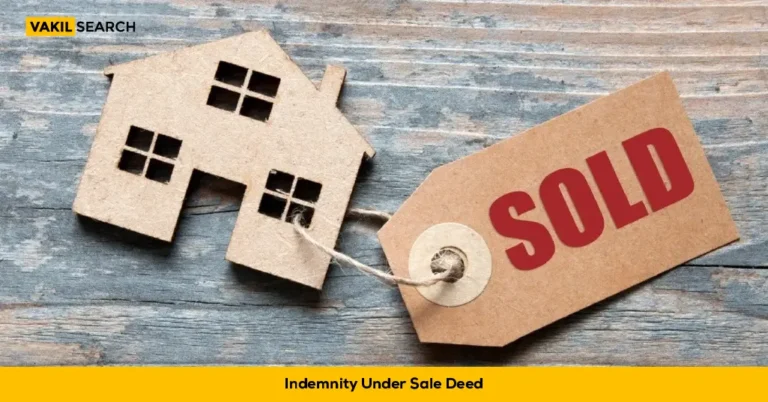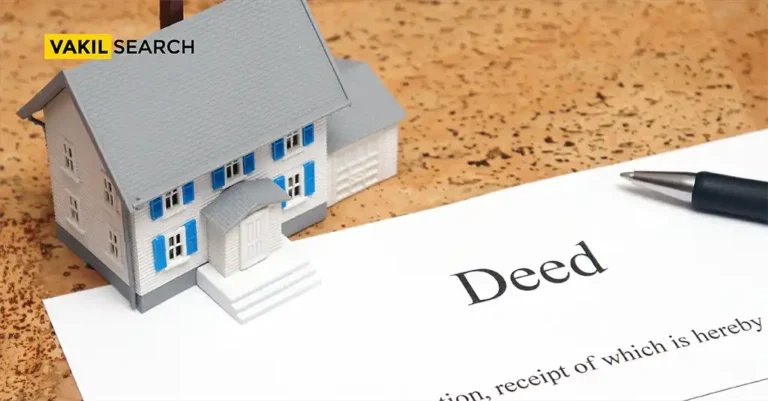Learn the importance of choosing the right sale deed format. This blog covers key considerations and best practices to ensure legal compliance and a smooth transfer of ownership.
What is a Sale Deed?
A Sale Deed stands as a pivotal legal instrument in property transactions, binding the seller and purchaser. Also known as the ‘grantor’ and ‘grantee,’ these parties engage in the transfer of property ownership. This document signifies the definitive shift of ownership from seller to buyer, solidifying the transaction’s completion.
In essence, a Sale Deed serves as irrefutable evidence of this transfer, meticulously describing the property and delineating each party’s rights and responsibilities. Crafted on a non-legal stamp paper of value specified by the state government, this deed demands careful consideration. While ready-made templates exist, customization is often necessary, with clauses added, modified, or removed as required.
The Sale Deed’s significance is undeniable for anyone involved in property dealings. Its role extends beyond a mere record; it safeguards interests and seals ownership transitions with legal precision.
How to Draft a Sale Deed
Transferring property via a Sale Deed involves a systematic process to ensure accuracy and legality. Follow these steps for a successful property transaction:
Step 1: Understand Your Requirement
- Hire a lawyer to guide you through the process.
- Discuss your property transfer needs and goals with the lawyer.
Step 2: Drafting the Sale Deed
- Based on your discussions, the lawyer prepares the Sale Deed.
- Within three working days, the lawyer drafts the document for your review and approval.
Step 3: Print the Sale Deed
- Once you approve the draft, the Sale Deed is printed on a non-judicial stamp paper.
Step 4: Fix an Appointment with the Sub-Registrar
- Your lawyer arranges an appointment with the relevant sub-registrar’s office overseeing the property’s jurisdiction.
Step 5: Register the Sale Deed
- Visit the sub-registrar’s office with two witnesses and your lawyer.
- Sign the Sale Deed and pay the necessary registration fees.
Step 6: Obtain a Registered Sale Deed
- After signing and payment, the sub-registrar’s office issues the registered Sale Deed.
- By following these clear steps, you can confidently navigate the process of drafting and registering a Sale Deed, ensuring a legally sound property transfer.
Documents Required for Sale Deed Registration
- Sale Deed Draft
- Applicable Power of Attorney
- Statutory Authority Approved Building Plan
- Builder/Co-Operative Society/Housing Board Allotment Letter
- Property Owner’s Title Documents
- Copies of Registered Previous Agreements (for resale property)
- Latest Receipts for Paid Taxes
- Current Electricity Bill and Receipt (for resale property)
- No Objection Certificate from Apartment Association (for resale property)
Clauses in a Sale Deed
A sale deed, serving as the cornerstone of property transactions, is an intricate legal document that establishes the ownership transfer of real estate. Within its pages, a myriad of clauses intricately intertwine to safeguard the interests of both parties involved. These clauses ensure that the property’s transfer is seamless, legally sound, and free from any encumbrances. Let’s delve into some of the pivotal clauses that constitute a comprehensive sale deed:
Parties Involved in the Sale Deed:
This fundamental clause introduces the key players – the buyer and seller. Elaborating upon their identities, addresses, ages, contact details, and occupations, it meticulously binds these individuals in a legal pact. The names of the parties are meticulously cross-referenced with the official property documents to guarantee accuracy. Even if executed through Power of Attorney, the specifics of such delegation are methodically outlined. The clause underscores the importance of verifying legal competency before proceeding with the transaction.
Description of the Property:
A vital component, this clause meticulously unveils the property’s dimensions and attributes. Whether a sprawling plot or a cosy apartment, the clause unveils its measurements, location, registration particulars, and construction details. A tangible representation, such as a graphical representation or a detailed schedule, might be appended for visual clarity, cementing an unambiguous understanding between parties.
The Sale Consideration:
At the heart of every sale, the consideration clause casts a spotlight on the financial aspect. Articulating the price at which the property is transferring hands, it underscores the unanimous agreement reached by both parties. This sum is cast in both numeric and textual forms to eliminate any ambiguity.
The Payment Method Clause:
This section meticulously lays out the channels through which the buyer will remit the payment. Cognizant of potential future disputes, this clause seeks to circumvent ambiguities by detailing the accepted methods, be it cash, cheque, demand draft, or digital transactions.
Advance Payment and Instalments:
Often, property transactions involve advance payments or instalments. This clause delineates the specifics of such arrangements. Should the buyer commit an advance payment, the deed chronicles the amount and further facilitates the calculation of the remaining balance. In instances of instalment-based payments, this clause defines the schedule, facilitating a transparent payment structure.
Transfer of Title Clause:
A cornerstone of ownership transfer, this clause formally recognises the transition of ownership. Articulating the ‘words of conveyance,’ it highlights the seller’s intent to vest the buyer with full ownership rights. Whether instantaneous or time-bound, this clause consummates the transference of all rights from seller to buyer.
Delivery of the Deed and Possession:
With an eye towards seamless transition, this clause underscores the date on which the property shifts into the buyer’s possession. Concurrently, it reiterates the delivery of the sale deed itself, accompanied by other essential documents. These may include occupation certificates, encumbrance certificates, and other proofs of title legitimacy.
Indemnity and Encumbrance Clause:
To ensure a clean slate, this clause safeguards the buyer against encumbrances and demands. It obliges the seller to indemnify any existing charges, arrears, or claims against the property, should they arise. If amenable, an encumbrance clause might allow the buyer to inherit specific liabilities, like mortgages.
Witness and Registration:
Ensuring legality and authenticity, this clause necessitates the presence of witnesses during the sale deed’s execution. Their attestations, along with the parties’ signatures, reinforce the document’s credibility. Subsequently, the deed must be duly registered with the appropriate authorities to validate the transaction’s legality.
Right to Quiet Enjoyment:
A covenant that resonates with property buyers, this clause assures peaceful and undisturbed property usage. It bars the seller or any other party from encroaching upon the buyer’s rightful ownership and enjoyment.
Miscellaneous Clauses:
In addition to the aforementioned, sale deeds might also include provisions like ‘Reddendum’ or ‘Reservation’ clauses that empower the seller with certain rights even after transfer, ‘Time is of the Essence’ clauses that stress timely execution, or ‘Right to Call Off’ clauses allowing withdrawal under specified circumstances. Additionally, ‘Dispute Resolution’ clauses establish alternate mechanisms to settle conflicts outside the courts.
Mandatory Disclosures To Be Obtained From Seller of Property For Sale Deed
When venturing into the realm of property transactions, a crucial legal framework ensures transparency and safeguards the interests of both buyers and sellers. Within this framework, the Transfer of Property Act, 1882, stands as a beacon, guiding the necessary disclosures and representations that property sellers must provide before the completion of a sale deed. Section 55 of this Act, which delves into the ‘Rights and liabilities of buyer and seller,’ mandates a series of vital obligations that sellers must fulfil to ensure a smooth and lawful property exchange.
Full Disclosure of Material Defects and Claims:
Section 55(1) of the Act places an obligation on the seller to provide comprehensive information about any material defects in the property or issues with the seller’s title. This encompasses third-party claims, disputes, and encumbrances that might impact the property’s ownership. Crucially, these disclosures must involve matters that the seller is aware of, but the buyer isn’t, and that the buyer wouldn’t easily discover through regular diligence.
Production of Title Documents:
To facilitate transparency and confidence in the transaction, the seller is obligated to produce all relevant documents of title to the property. These documents, which should be in the seller’s possession or control, allow the buyer to examine the property’s legal history and ownership lineage, ensuring that there are no hidden complications.
Honest Responses to Buyer’s Queries:
The Act mandates that the seller provides accurate and truthful answers to any queries posed by the buyer concerning the property or its title. This includes divulging any pertinent information that could impact the buyer’s decision, thereby fostering an environment of trust and informed decision-making.
Proper Execution of Conveyance:
Upon the buyer’s fulfilment of the agreed-upon payment, the seller is obligated to execute a proper conveyance of the property. This act solidifies the legal transfer of ownership and is crucial to the completion of the sale. The seller is expected to adhere to this obligation promptly and within the defined parameters.
Care of Property and Documents:
Between the contract signing and property delivery, the seller is responsible for maintaining the property’s condition and safeguarding all associated documents. This ensures that the property remains in the condition it was in when the sale was negotiated, instilling buyer confidence and trust.
Providing Possession of the Property:
Should the buyer request possession of the property during the interim period, the seller is obliged to provide it. While the nature of the property might dictate the extent of possession that can be granted, the Act ensures that the seller complies with such reasonable requests.
Clearance of Charges and Rent:
In the interest of a seamless transaction, the seller is mandated to clear all government charges and rent that have accrued on the property up to the sale date. This ensures that the property is transferred free of any outstanding financial obligations.
Assurance of Nil Encumbrance or Lien:
Lastly, the Act emphasises that the seller must ensure that there are no encumbrances or liens on the property. This assurance forms the foundation of a clean and lawful property transfer, guarding the buyer against future legal complexities.
In essence, Section 55(1) of the Transfer of Property Act, 1882, compels property sellers to adhere to a set of stringent and vital obligations. These obligations collectively serve to enhance transparency, foster trust, and safeguard the interests of both parties involved in the property transaction. By fulfilling these obligations, property sellers contribute to the creation of a secure and just property market.
How to Get a Certified Copy of a Lost Sale Deed?
A sale deed, as a cornerstone of property transactions, holds immense legal significance as it signifies the shift of ownership from seller to buyer. Safeguarding this crucial document is of utmost importance, yet situations arise where the original sale deed is misplaced or lost. If you find yourself in such a predicament, rest assured that the process to obtain a certified copy or duplicate sale deed is well-defined and accessible. Here’s a step-by-step guide on how to navigate through the process effectively:
Step 1: Initiate an FIR
The initial course of action involves filing a First Information Report (FIR) at the local police station. This report is essential to establish the loss of a vital document or property. To ensure its validity, double-check the complainant’s signature, the Police Station’s stamp, the Duty Officer’s signature, and the FIR number. If, despite police efforts, the original sale deed remains untraceable, a non-traceable certificate confirming its loss will be issued.
Step 2: Publish an Advertisement
To demonstrate to the sub-registrar’s office that you’ve made diligent efforts to recover the missing document, publishing an advertisement in a prominent newspaper is imperative. This advertisement should encompass comprehensive details regarding the lost sale deed. This step underscores your genuine intent to locate the document. Even if the document still eludes discovery after the advertisement, you can proceed with the next step.
Step 3: File an Affidavit and Application
Now equipped with evidence of earnest attempts to retrieve the sale deed, you can proceed to submit an application at the jurisdictional sub-registrar’s office. Prepare a notarised affidavit that includes the following:
- Thorough property details.
- Attached copy of the FIR.
- Attached copy of the non-traceable certificate.
- Attached copy of the newspaper advertisement.
- An affirmation of the veracity of the information presented.
Step 4: Submission to the Sub-registrar
Present the notarised affidavit, along with the application for a certified copy of the sale deed, to the sub-registrar’s office. Ensure you also include the requisite fee. This step seals the authenticity of your efforts to retrieve the original sale deed.
Step 5: Await the Certified Copy
After submitting your application and affidavit, the sub-registrar’s office will process your request. Within a span of 2 to 4 weeks, you can anticipate the issuance of the certified copy of the sale deed. This certified copy holds the same legal validity as the original document and serves as a testament to your genuine efforts in ensuring a comprehensive property transaction history.
In a world where paperwork can sometimes be prone to unexpected losses, the legal system offers a structured path to rectify such situations. By meticulously following these steps, you can navigate through the process of obtaining a certified copy of a lost sale deed, ensuring that your property transaction remains secure and lawfully documented.
FAQs
What is the meaning of the original sale deed?A sale deed is a legal instrument that delineates the terms and conditions of a sale, duly signed by both the seller and the buyer to effect the transfer of property ownership. |
Who keeps the original sale deed?The buyer holds onto the original sale deed document. If there are several buyers involved, it’s important to designate a primary buyer from among them. The buyers need to create an affidavit to designate one representative from the group of buyers. |
Who pays for the sale deed in India?In India, the buyer is typically responsible for covering the expenses related to the sale deed. |
What is the sale deed value?The sale deed must include the mutually agreed-upon sale price, representing the amount the buyer pays the seller upon execution, and any pre-paid advances should also be clearly stated within the document. |
Also, Read:










